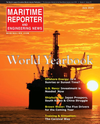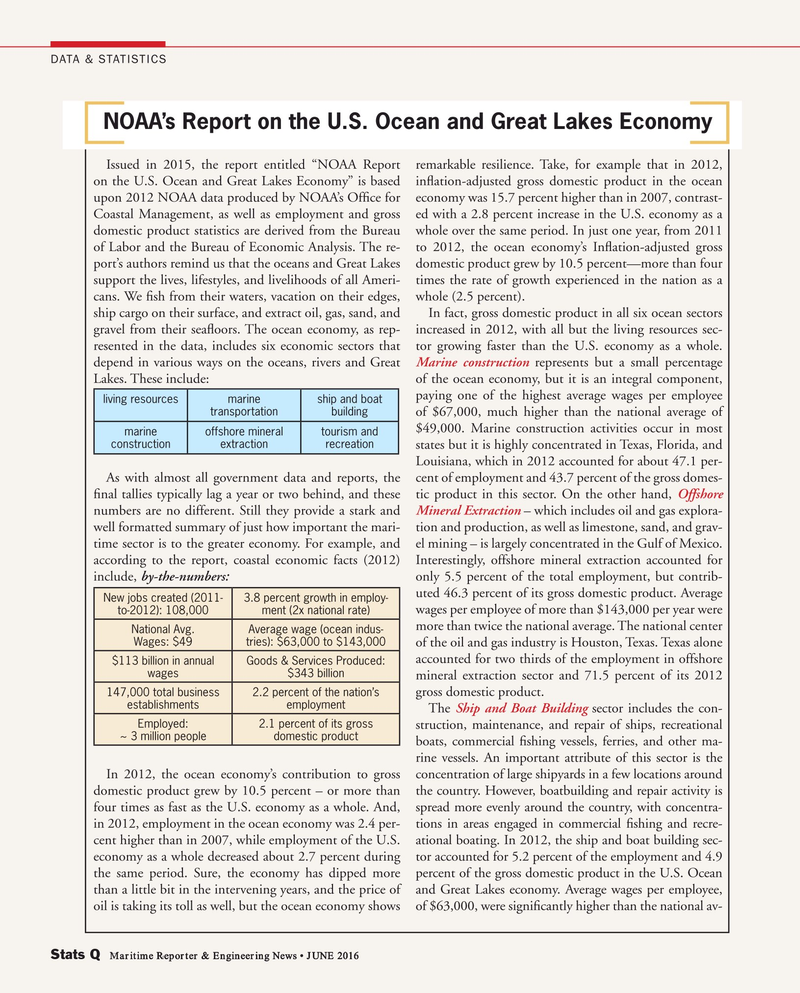
Page 83: of Maritime Reporter Magazine (June 2016)
Annual World Yearbook
Read this page in Pdf, Flash or Html5 edition of June 2016 Maritime Reporter Magazine
DATA & STATISTICS
NOAA’s Report on the U.S. Ocean and Great Lakes Economy
Issued in 2015, the report entitled “NOAA Report remarkable resilience. Take, for example that in 2012, on the U.S. Ocean and Great Lakes Economy” is based in? ation-adjusted gross domestic product in the ocean upon 2012 NOAA data produced by NOAA’s Of? ce for economy was 15.7 percent higher than in 2007, contrast-
Coastal Management, as well as employment and gross ed with a 2.8 percent increase in the U.S. economy as a domestic product statistics are derived from the Bureau whole over the same period. In just one year, from 2011 of Labor and the Bureau of Economic Analysis. The re- to 2012, the ocean economy’s In? ation-adjusted gross port’s authors remind us that the oceans and Great Lakes domestic product grew by 10.5 percent—more than four support the lives, lifestyles, and livelihoods of all Ameri- times the rate of growth experienced in the nation as a cans. We ? sh from their waters, vacation on their edges, whole (2.5 percent).
ship cargo on their surface, and extract oil, gas, sand, and In fact, gross domestic product in all six ocean sectors gravel from their sea? oors. The ocean economy, as rep- increased in 2012, with all but the living resources sec- resented in the data, includes six economic sectors that tor growing faster than the U.S. economy as a whole. depend in various ways on the oceans, rivers and Great Marine construction represents but a small percentage
Lakes. These include: of the ocean economy, but it is an integral component, paying one of the highest average wages per employee living resourcesmarine ship and boat transportation building of $67,000, much higher than the national average of $49,000. Marine construction activities occur in most marine offshore mineral tourism and construction extraction recreation states but it is highly concentrated in Texas, Florida, and
Louisiana, which in 2012 accounted for about 47.1 per-
As with almost all government data and reports, the cent of employment and 43.7 percent of the gross domes- ? nal tallies typically lag a year or two behind, and these tic product in this sector. On the other hand, Offshore numbers are no different. Still they provide a stark and Mineral Extraction – which includes oil and gas explora- well formatted summary of just how important the mari- tion and production, as well as limestone, sand, and grav- time sector is to the greater economy. For example, and el mining – is largely concentrated in the Gulf of Mexico. according to the report, coastal economic facts (2012) Interestingly, offshore mineral extraction accounted for include, by-the-numbers: only 5.5 percent of the total employment, but contrib- uted 46.3 percent of its gross domestic product. Average
New jobs created (2011- 3.8 percent growth in employ- wages per employee of more than $143,000 per year were to-2012): 108,000 ment (2x national rate) more than twice the national average. The national center
National Avg. Average wage (ocean indus-
Wages: $49 tries): $63,000 to $143,000 of the oil and gas industry is Houston, Texas. Texas alone accounted for two thirds of the employment in offshore $113 billion in annual Goods & Services Produced: wages $343 billion mineral extraction sector and 71.5 percent of its 2012 gross domestic product.
147,000 total business 2.2 percent of the nation’s establishments employment
The Ship and Boat Building sector includes the con-
Employed: 2.1 percent of its gross struction, maintenance, and repair of ships, recreational ~ 3 million people domestic product boats, commercial ? shing vessels, ferries, and other ma- rine vessels. An important attribute of this sector is the
In 2012, the ocean economy’s contribution to gross concentration of large shipyards in a few locations around domestic product grew by 10.5 percent – or more than the country. However, boatbuilding and repair activity is four times as fast as the U.S. economy as a whole. And, spread more evenly around the country, with concentra- in 2012, employment in the ocean economy was 2.4 per- tions in areas engaged in commercial ? shing and recre- cent higher than in 2007, while employment of the U.S. ational boating. In 2012, the ship and boat building sec- economy as a whole decreased about 2.7 percent during tor accounted for 5.2 percent of the employment and 4.9 the same period. Sure, the economy has dipped more percent of the gross domestic product in the U.S. Ocean than a little bit in the intervening years, and the price of and Great Lakes economy. Average wages per employee, oil is taking its toll as well, but the ocean economy shows of $63,000, were signi? cantly higher than the national av-
Stats Q Maritime Reporter & Engineering News • JUNE 2016
STATS III.indd 34 STATS III.indd 34 6/20/2016 5:07:00 PM6/20/2016 5:07:00 PM
MN Dec15 Layout 1-17.indd 8 11/24/2015 10:24:38 AM

 82
82

 84
84
